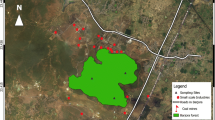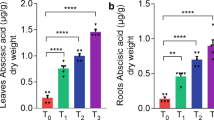Abstract
The effect of stone dust deposition on the rate of transpiration in Shorea robusta was studied in three principal seasons in a polluted forest in comparison to an almost non-polluted forest. The extent of particulate pollution was determined by measuring suspended particulate matter in the air and dust fall on leaf surface. Macroscopic and microscopic leaf injury symptoms were studied. Scanning electron microscopic examination of leaf surfaces revealed a number of foliar anomalies. Qualitative determination of rate of transpiration in field condition was done by ‘cobalt chloride method’. It was found that transpiration was diminished as a result of foliar dust deposition which not only caused blockage of stomatal aperture but also physical damage to the leaf surface. Thus, particulate air pollution can be considered as one of the external factors regulating the rate of transpiration in plants.



Similar content being viewed by others
References
Abdulrahaman AA, Oladele FA (2009) Stomatal features and humidification potentials of Borassus aethiopum, Oreodoxa regia and Cocos nucifera. Afr J Plant Sci 3(4):059–063
Acharekar C, Salgare SA (1993) Effect of ambient air on growth performance, micromorphology, chlorophyll content of leaf and organic content of seeds of some wild plants. In: Tripathi AK, Srivastava AK, Pandey SN (eds) Advances in environmental studies. APH Publishing, New Delhi
Anandacoomaraswamy A, De Costa WAJM, Shyamalie HW, Campbell GS (2000) Factors controlling transpiration of mature field-grown tea and its relationship with yield. Agric For Meteorol 103(4):375–386
Bailey LF, Rothacher IS, Cummings WH (1951) A critical study of the cobalt chloride method of measuring transpiration. Plant Physiol 27:563–574
Central Pollution Control Board, India (CPCB) (1995) Air pollution and its control. Parivesh News Lett 2(1):10
Gangulee HC, Das KS, Dutta C (2002) College botany. Vol. 1, chapter XXXVI, reprint of 6th edn. New Central Book Agency (P) Ltd, Kolkata, pp 476–477
Hanami Y (1972) Effects of environmental factors upon transpiration. In: ISHS Acta Horticulturae 39: symposium on basic problems of protected vegetable production
IM (2005) Calculations for suspended particulate sampling. In: Instruction manual for high volume sampler (Envirotech APM 415). Vayubodhan Upakaran Pvt. Ltd, New Delhi, India, p 21
Jalees K, Dave JM (1979) Techniques for particulate sampling and analysis: an evaluation. Ind J Air Pollut Control 2:29–32
MoEF Notification (1986) The Environmental (Protection) Rules, 1986. Ministry of Environment and Forest, Government of India, New Delhi (Department of Environment, Forest and Wildlife), Notification published on 19 Nov 1986
Molnar L, Meszaros I (1994) Limited transpiration during the long dry summer period. FRIEND: flow regimes from International Experimental and Network Data. In: Proceedings of the Braunschweig Conference, Oct 1993, IAHS Publ. no. 221
Patil MA (2001) Environmental management scenario in stone crusher industry sector and cleaner production possibilities. TERI Inf Monit Environ Sci 6(2):83–92
Rao DN (1971) A study of air pollution problem due to coal unloading in Varanasi, India. In: Englend MM, Beny GT (eds) Proceeding of second International Air Congress. Academic Press, New York, p 273–276
Rao DN (1985) Plants and particulate pollutants. In: Subrahmanyam GV, Rao DN, Varshney CK, Biswas DK (eds) Air pollution and plants: a state-of-the-art report. Ministry of Environment and Forests, Department of Environment, Govt. of India, New Delhi
Saha DC, Padhy PK (2011a) Effects of stone crushing industry on Shorea robusta and Madhuca indica foliage in Lalpahari forest. Atmospheric Pollut Res 2:463–476
Saha DC, Padhy PK (2011b) Effect of air and noise pollution on species diversity and population density of forest birds at Lalpahari, West Bengal, India. Sci Total Environ 409(2011):5328–5336
Tandon A, Yadav S, Attri AK (2010) Coupling between meteorological factors and ambient aerosol load. Atmospheric Environ 44(9):1237–1243
Xiong-wen C (2001) Study of the short-time eco-physiological response of plant leaves to dust. Acta Bot Sin 43(10):1058–1064
Acknowledgments
We express our deep sense of gratitude to the respective forest officers and personnel for allowing us to carry out studies in the forests. We are thankful to respective officers and personnel of meteorological stations and irrigation farms for supplying necessary data. Finally, we also thank two anonymous reviewers for their comments and suggestions, which improved the quality of our MS.
Author information
Authors and Affiliations
Corresponding author
Additional information
Communicated by R. Matyssek.
Rights and permissions
About this article
Cite this article
Saha, D.C., Padhy, P.K. Effect of particulate pollution on rate of transpiration in Shorea robusta at Lalpahari forest. Trees 26, 1215–1223 (2012). https://doi.org/10.1007/s00468-012-0697-4
Received:
Revised:
Accepted:
Published:
Issue Date:
DOI: https://doi.org/10.1007/s00468-012-0697-4




